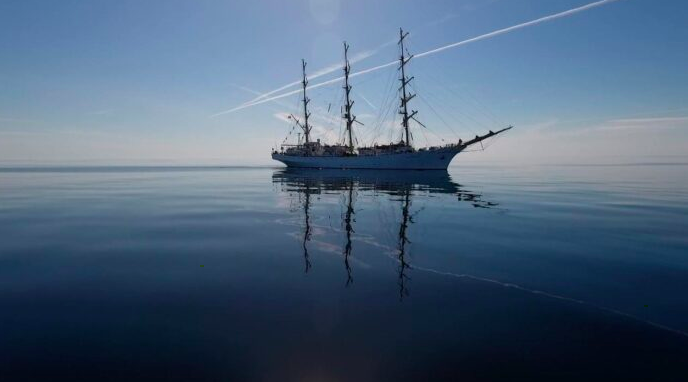Death onboard vessel shocks sail training world

Edit: new information included about the tragic incident – statement from Gdynia Maritime University.
A tragic accident aboard Dar Młodzieży has left one student dead. Early reports suggest that Dar Młodzieży was on a one-day training cruise. There were about 150 people on board – including university students and high school students. According to Polish News (https://www.polishnews.co.uk/gdynia-a-tragic-accident-aboard-dar-mlodziezy-the-sailing-ship-returned-to-port/), the sailing ship returned to the port of Gdynia where there were representatives of the university waiting.
World Today News says a young man fell from a great height. This, the source says, was confirmed by spokesman for the local Maritime Search and Rescue Service.
“It is with sadness and pain that we inform you about the suicidal death of a student of the West Pomeranian Centre for Maritime Education and Polytechnic Education in Szczecin during his maritime internship at Dar Młodzieży,” says a statement from Gdynia Maritime University.
“The internship, in which our students also participate, began with embarking on the ship on July 14, 2020 and should end on August 12.
“The investigation into the death is conducted by the Police and the Prosecutor’s Office. Due to the fact that it was a fatal accident, the case is also being investigated by the Maritime Accident Investigation Commission and the Ship’s Emergency Team.
“At the express request of the family, we avoid speculation about the student’s mental health and the circumstances of his death.
“We provided psychological care for the apprentices and the training cruise crew. Since yesterday, there are psychologists, a priest, an educator and the director of the Szczecin Centre.
“Until the investigation is completed, the ship will remain at the quay. Students who decide to continue their practice stay on board. The rest who want to stop the cruise are returning to Szczecin today, they will complete their internship at a different date.
“We express our sympathy to the family and all relatives and declare the widest possible support.”
Dar Mlodziezy is owned by the Gdynia Maritime Academy and has been since she was built in 1982. Her name means ‘the gift of youth’ and she replaced the beautiful frigate Dar Pormoza which had trained future officers of merchant and fishing fleets for over fifty years, according to Sail Training International. She has graced the Tall Ships’ Races with her presence on a regular basis for around 25 years and has undertaken circumnavigations of the globe which included the 200th anniversary of Australia in Sydney in 1988.
World Today News says the vessel is over 100m, with masts reaching up to 50m.
“I was sorry to hear about the tragic accident on board Dar Mlodziezy,” says Lucy Grodie from the UK Association of Sail Training Organisations (ASTO, based in Gosport). “Accidents like these are rare on tall ships, they have a very good safety record of taking thousands of young people to sea for challenge and adventure.”
But the incident is a shocking reminder that, in spite of great advances in safety and training, tragic accidents still take place on tall ships, though the numbers are small compared with the heyday of commercial sail from the early 19th to the early 20th centuries.
As Peter Cardy (charity analyst, and volunteer watch leader with JST for over ten years) points out in his exploration of training ship accidents, Sailing Ships, a catalogue of disasters “It is a sad but constant fact that around the world, commercial ships founder, crews drown, are burnt or blown to pieces without a flicker of interest from the media. Let a sailing ship be in trouble, especially one with a crew of young people, it will command the headlines for days.”
He’s well aware of tall ship sailing accidents over the past few decades of which many he describes as avoidable.
“Many were failures of design, seamanship, maintenance or even common sense, but it was not known at which point the failure would become critical,” Cardy says.
“Gathering first-hand accounts of how an emergency unfolded is traumatic for the teller and exposes enduring psychological scars, though it is essential in preparing for future incidents. But at some point after the formal processes the masters and survivors will, if anyone asks, tell their stories for the benefit and safety of others.”
And it’s within these stories he finds common strands.
Like the case of Astrid. Built in 1918, she was a trading vessel who, after a ‘colourful’ career, was burnt out but re-rigged as a brig in the 1980s. She was used as a sail training vessel and a commercial yacht on the Netherlands flag.
In July 2013 she embarked trainees for a voyage from Southampton for Kinsale to join The Gathering Cruise. The owner was skippering the ship. After leaving Oysterhaven the track took the ship close inshore, where there would be good photo opportunities.
During sail handling under power, in moderate wind and seas the engines failed and the ship was driven onto the rocks. There was a bungled attempt to send a Mayday, yet the ship’s entire complement was rescued uninjured by the RNLI and the Coastguard. The ship was a total loss.
The Irish Marine Casualty Investigation Board reported that that there had been problems with water contamination of fuel in the days before the accident. This was the direct cause of the engine failure and thus the immediate cause of the grounding. The report also listed incomplete certification of the ship, its safety gear, the master and officers, along with the log book and other documents.
“It would be pleasing to report that this was the last accident, but it is not so,” Cardy says. “In most years since the wreck of Astrid there has been at least one loss or serious accident involving a sailing ship in north Atlantic or European waters, not all officially reported or investigated. Sail Training International, Tall Ships America and the UK’s Association of Sail Training Organisations are organisers of tall ships events rather than regulators. They share information, anonymously if need be, and are eager to hear of accidents and what lessons are to be learned and broadcast.”
There were shocking similarities between Astrid and the fate of Maria Asumpta.
She began life around 1858 as a transatlantic trading brig. Converted to power and de-rigged, she was purchased by the so-called China Clipper Society. In 1995 after a major structural and engineering refit she left Swansea for Padstow in north Cornwall.
Making a close pass of Rumps Point for filming and publicity she began to luff. The engines failed to start. She hit a rock and in a few minutes was smashed to fragments in full view of the spectators. Abandon ship was ordered but not co-ordinated: lifejackets were stowed below and though the life rafts inflated, they were not used. Three people died. The master was tried in court and imprisoned, a rare outcome in such cases.
Although sailing ships have become safer as a result of regulation and technology (for example a squall can often be seen on radar and avoided, while weather forecasting has improved immeasurably), says Cardy, a sailing ship remains more complex than power-driven ships. Although all are operating in the two fluids of water and air, the sailing vessel depends on their interaction and pokes its mast up into the wind and its keel down into the sea, introducing infinite variables into its passage.
It is apparent when the master of a motor ship has learned their craft on sailing ships and is at ease in a multi-dimensional world, he believes. The advantages of qualifying seatime on sailing ships are obvious to most of the world’s maritime nations, but not apparently to the UK, where cadets struggle to gain acceptance. And the UK remains one of the few maritime nations without a national sailing ship.
Read Peter Cardy’s full exploration of Sailing Ships, a catalogue of disasters, and What really happened in JST’s £1m appeal?.











Accidents like these are indeed tragic. However, I’d like to reiterate that compared to the number of people going to sea safely on these ships, fatal accidents are very rare. As Peter Cardy says, there are many more incidents on commercial ships and fishing boats that don’t make the headlines.
The Sail Training world is getting better at sharing what lessons can be learnt from these incidents and we have regular sessions at conferences discussing these. The risks of going aloft are small compared to the huge benefits of learning life skills such as confidence and teamwork.
We will need to wait for the official report into the causes of this accident, but the first statements from the operators sadly point to possible suicide: https://umg.edu.pl/aktualnosci/2020/nieszczesliwy-wypadek-na-darze-mlodziezy .
It was a suicide! It had nothing to do with safety. Linkin it with other accident on tall ships (which are very rare) is rather lack of knowledge or good will. Was it really so hard to do some simple research? All police reports and also the ship owner’s statement state that it was a suicide. Why didn’t the author mention it in the article?
The article was written before the statement was released. It is very sad indeed for all involved.
This is indeed a tragic event. However I would like to reiterate that fatal accidents on board Tall Ships are very rare. As Peter Cardy says, commercial ships and fishing boats have plenty of accidents that don’t make the news.
The Sail Training community regularly shares details of incidents and discusses them at their conferences, in order to prevent similar accidents in future. While we won’t know the details of this incident until the investigation has concluded, first statements from the vessel operators suggest this may sadly have been suicide: https://umg.edu.pl/aktualnosci/2020/nieszczesliwy-wypadek-na-darze-mlodziezy
The relatively small risk of going aloft on a Tall Ship are outweighed by the vast benefits to the Trainees who gain self-confidence, resilience and teamwork skills.
@Zella Compton
The article was published on 22nd of July. The boy died on 20th of July. On the same day the police indicated suicide as the most probable reason. Their opinion was quoted by several Polish media. It was only a question of research. Something that every journalist has to do before writing an article.